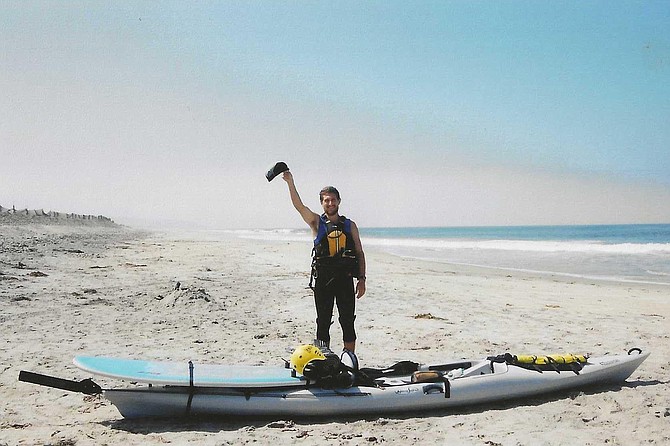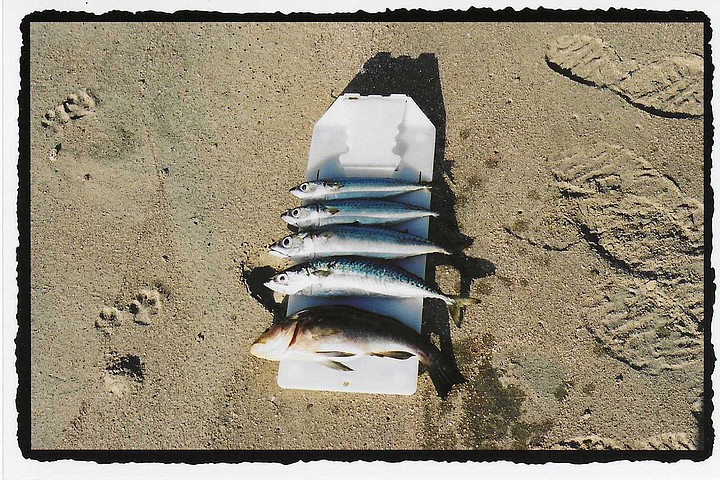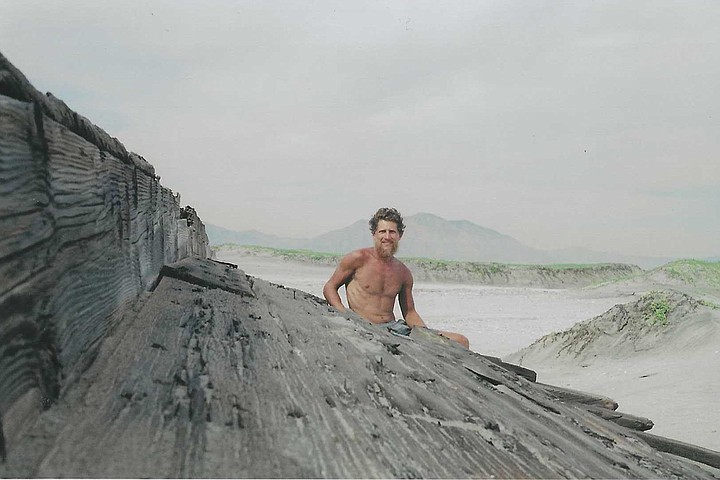 Facebook
Facebook
 X
X
 Instagram
Instagram
 TikTok
TikTok
 Youtube
Youtube

Recently, I had dinner at a small gathering in Mission Beach hosted by some new friends, Dimitri and Ali Kalemkeris, in a charming cottage that was built in the time of Ali’s grandparents. Soon after arriving, I noticed a small wooden frame on the main hallway’s wall, holding, in miniature form, a kayak as seen from top and side, a paddle, and a palm tree. The frame also held a brass plaque that read “Kayak to Cabo/ 1050 miles alone/ Aug 4 to Nov 6 /2003.”
“Whose trip is this a tribute to?” I asked my host, who told me it was in fact his own. About 20 years ago, he had kayaked, solo and unsupported, from San Diego all the way to San Jose del Cabo at the Southern end of Baja. His uncle-in-law had made this piece for him shortly after his return. We didn’t have a chance to talk more about it that night, but I met him again soon after in order to hear a fuller account of his odyssey.

Dimitri’s love for the ocean and being in the water began, he said, when he developed an interest in surfing as a teenager. “Interest” is perhaps too mild a word. Though he was a child of the inland Pacific Northwest, and though he had no experience surfing, he began driving out to the coast of Oregon and very northern California, where he just taught himself how to do it. He carried on when he moved to San Diego in 1996. “All I did was surf,” he said. “I worked in a coffee shop in La Jolla. I just ate bagels every day and surfed my brains out.”
Then he discovered the ocean’s opposite: the desert. “The Anza Borrego, specifically,” which he said had “a geography and a spatial atmosphere that was totally new to me. I fell in love with it.” He spent a great deal of time out there, deepening his knowledge and wilderness skills through a Sierra Club class.
Those two loves started him looking at Baja, where the sands and sea were in close proximity. He developed a vision of a journey through this land, close by and yet foreign to him. And since he did not want to travel by car or plane, kayaking ended up being his best option. So he started getting familiar with the boats, trying out various versions before settling on a sit-on-top type that had enough storage for his needs. In addition to food, he carried fishing line, a diving knife, a camera, a radio (defunct by the third or fourth day), a surfboard, a Global Star satellite phone in a waterproof bag, and a desalinator for drinking water. His weather report was provided by what he could see or hear. He did not bring much knowledge of Spanish with him. A friend said that Viaje al Cabo was all he’d really need to be able to say, and that is what he would eventually tell curious people, pointing south as he did so.

As he prepared for what he knew would be a long and somewhat dangerous trip, Dimitri felt mostly optimistic. But he acknowledged that “to do something like this, there has to be a little bit of letting go of your potential for survival. I had to come to terms with that.” (At that point, he was not yet a father.)
Though he’d never actually been to Imperial Beach, that was his chosen point of departure, and on a sunny summer morning, he set out, feeling “like Huck Finn lighting out for the territory.” He recalled, “I felt very happy, and kind of a sense of freedom. The sun was shining, kind of an uplifting feeling. I didn’t check in at any office.” He headed “far out enough that I kind of blended into the horizon,” and once out there, amid the freedom of the sea, he paddled south past the walls and checkpoints and into Mexican waters. He was on his way.
At first, he had the bustling northwest of Baja California for company — its noise, light, and activity. But there would be many remote and quiet stretches between the top and the bottom of Baja. Sometimes, the journey was pleasant and reflective. He appreciated the solitude. Eventually, he felt more and more attuned to the energetic pulse of the natural life around him. His dreams grew more vivid. And he “started to reflect on the past. And this deep emotional wellspring kind of opened up, and this deep sense of appreciation, not just for people and for my past, but the landscape, the beauty of the earth, the animals.” He saw remote sights. He had some warm encounters with generous people who wanted to buy him food. On one ravenous night, he discovered a new appreciation for Hostess Twinkies and cupcakes, which he bought from a little shop in a fishing village. Boy, that’s going to taste good, he thought as he paddled to his campsite with his sugary treasure.
There were also periods of fear, hunger, and disorientation. At one campsite, he had to hide from a suspicious late night visitor. He wept after losing fish that could have been dinner. And at several points, hours of paddling in fog led him to doubt his compass. The endless repetition of paddling left him feeling spacey and removed. Once, he thought, Boy, those hands in front of me are starting to get really annoying. “You start to go nuts.”
After three months, he made it to San Jose del Cabo. The trip, he said, was like “a dual journey. There’s two aspects to something like this. There’s the exterior aspect, the adventure — ‘This happened, I saw this, there was a big wave, there were these animal encounters.’ And then there’s an interior kind of aspect, which is just as fascinating.” He says that he still carries the experience — and in some way, the landscape — within him. “Parts of it never leave you.”


Recently, I had dinner at a small gathering in Mission Beach hosted by some new friends, Dimitri and Ali Kalemkeris, in a charming cottage that was built in the time of Ali’s grandparents. Soon after arriving, I noticed a small wooden frame on the main hallway’s wall, holding, in miniature form, a kayak as seen from top and side, a paddle, and a palm tree. The frame also held a brass plaque that read “Kayak to Cabo/ 1050 miles alone/ Aug 4 to Nov 6 /2003.”
“Whose trip is this a tribute to?” I asked my host, who told me it was in fact his own. About 20 years ago, he had kayaked, solo and unsupported, from San Diego all the way to San Jose del Cabo at the Southern end of Baja. His uncle-in-law had made this piece for him shortly after his return. We didn’t have a chance to talk more about it that night, but I met him again soon after in order to hear a fuller account of his odyssey.

Dimitri’s love for the ocean and being in the water began, he said, when he developed an interest in surfing as a teenager. “Interest” is perhaps too mild a word. Though he was a child of the inland Pacific Northwest, and though he had no experience surfing, he began driving out to the coast of Oregon and very northern California, where he just taught himself how to do it. He carried on when he moved to San Diego in 1996. “All I did was surf,” he said. “I worked in a coffee shop in La Jolla. I just ate bagels every day and surfed my brains out.”
Then he discovered the ocean’s opposite: the desert. “The Anza Borrego, specifically,” which he said had “a geography and a spatial atmosphere that was totally new to me. I fell in love with it.” He spent a great deal of time out there, deepening his knowledge and wilderness skills through a Sierra Club class.
Those two loves started him looking at Baja, where the sands and sea were in close proximity. He developed a vision of a journey through this land, close by and yet foreign to him. And since he did not want to travel by car or plane, kayaking ended up being his best option. So he started getting familiar with the boats, trying out various versions before settling on a sit-on-top type that had enough storage for his needs. In addition to food, he carried fishing line, a diving knife, a camera, a radio (defunct by the third or fourth day), a surfboard, a Global Star satellite phone in a waterproof bag, and a desalinator for drinking water. His weather report was provided by what he could see or hear. He did not bring much knowledge of Spanish with him. A friend said that Viaje al Cabo was all he’d really need to be able to say, and that is what he would eventually tell curious people, pointing south as he did so.

As he prepared for what he knew would be a long and somewhat dangerous trip, Dimitri felt mostly optimistic. But he acknowledged that “to do something like this, there has to be a little bit of letting go of your potential for survival. I had to come to terms with that.” (At that point, he was not yet a father.)
Though he’d never actually been to Imperial Beach, that was his chosen point of departure, and on a sunny summer morning, he set out, feeling “like Huck Finn lighting out for the territory.” He recalled, “I felt very happy, and kind of a sense of freedom. The sun was shining, kind of an uplifting feeling. I didn’t check in at any office.” He headed “far out enough that I kind of blended into the horizon,” and once out there, amid the freedom of the sea, he paddled south past the walls and checkpoints and into Mexican waters. He was on his way.
At first, he had the bustling northwest of Baja California for company — its noise, light, and activity. But there would be many remote and quiet stretches between the top and the bottom of Baja. Sometimes, the journey was pleasant and reflective. He appreciated the solitude. Eventually, he felt more and more attuned to the energetic pulse of the natural life around him. His dreams grew more vivid. And he “started to reflect on the past. And this deep emotional wellspring kind of opened up, and this deep sense of appreciation, not just for people and for my past, but the landscape, the beauty of the earth, the animals.” He saw remote sights. He had some warm encounters with generous people who wanted to buy him food. On one ravenous night, he discovered a new appreciation for Hostess Twinkies and cupcakes, which he bought from a little shop in a fishing village. Boy, that’s going to taste good, he thought as he paddled to his campsite with his sugary treasure.
There were also periods of fear, hunger, and disorientation. At one campsite, he had to hide from a suspicious late night visitor. He wept after losing fish that could have been dinner. And at several points, hours of paddling in fog led him to doubt his compass. The endless repetition of paddling left him feeling spacey and removed. Once, he thought, Boy, those hands in front of me are starting to get really annoying. “You start to go nuts.”
After three months, he made it to San Jose del Cabo. The trip, he said, was like “a dual journey. There’s two aspects to something like this. There’s the exterior aspect, the adventure — ‘This happened, I saw this, there was a big wave, there were these animal encounters.’ And then there’s an interior kind of aspect, which is just as fascinating.” He says that he still carries the experience — and in some way, the landscape — within him. “Parts of it never leave you.”
Comments